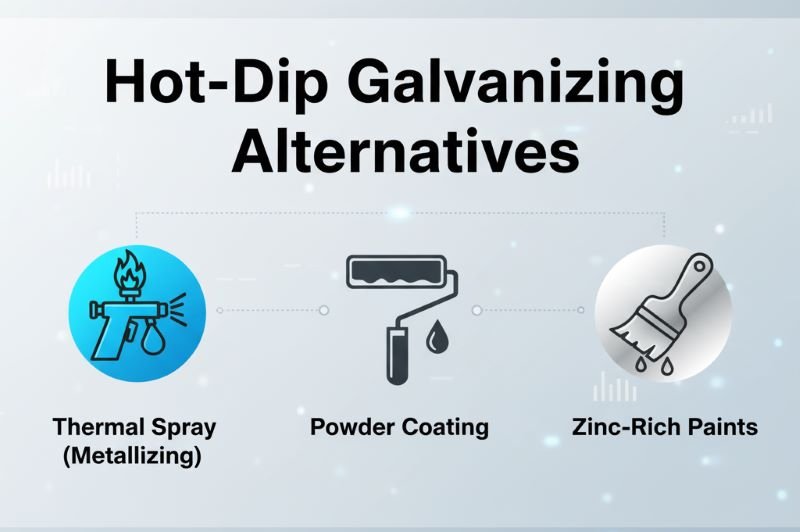🔥 Hot-Dip Galvanizing Alternatives: A Comprehensive Guide to Safer, Greener, & Durable Options
Hot-dip galvanizing (HDG) has long been the go-to method for protecting steel from corrosion. But its limitations—high costs, environmental hazards, and impracticality for large structures—have spurred innovation. Let’s explore 10 modern alternatives that offer comparable (or better) protection, sustainability, and flexibility!
1. 🎨 Powder Coating: The Aesthetic Shield
How It Works: Electrostatic application of dry polymer powder, cured into a durable finish.
- Pros:
- Customizable colors and finishes for branding or design needs.
- Eco-friendly—zero solvents, recyclable overspray, and no toxic runoff.
- Cost-effective: Upfront and long-term savings compared to HDG.
- Cons:
- Less durable than HDG (2–5 years vs. 50+ years).
- Vulnerable to UV degradation without top coatings.
Best For: Indoor equipment, architectural elements, and projects needing visual appeal.
2. ✨ Thermal Spray Galvanizing (Metal Spraying)
How It Works: Molten zinc or aluminum is sprayed onto surfaces using compressed air.
- Pros:
- No size limits—ideal for bridges, pipelines, and large structures.
- Portable: Can be applied on-site, unlike HDG’s fixed baths.
- Duplex systems: Combines with paint for enhanced durability.
- Cons:
- Requires meticulous surface prep (grit blasting).
- Higher skill requirement for uniform application.
Best For: Marine environments, infrastructure, and repairs on welded HDG surfaces.
3. ⚡ Electrogalvanizing/Electroplating
How It Works: Zinc is deposited via electricity in a chemical bath.
- Pros:
- Thin, uniform coatings for precision parts (e.g., fasteners).
- Lower zinc consumption than HDG.
- Cons:
- Prone to hydrogen embrittlement in high-strength steel.
- Shorter lifespan (1–5 years) due to thinner layers.
Best For: Small components like bolts, automotive parts, and electronics.
4. 🌱 Galv360® (Thermal Diffusion)
How It Works: Zinc gas diffuses into steel at low temps, forming an alloy layer.
- Pros:
- 2–3x longer lifespan than HDG 4.
- Zero toxic waste—EPA-approved and RoHS/REACH compliant.
- Uniform coating on complex geometries (e.g., chain links).
- Cons:
- Limited availability compared to traditional methods.
Best For: Military, marine, and power generation applications.
- Limited availability compared to traditional methods.
5. 🖌️ Cold Galvanizing (Zinc-Rich Paints)
How It Works: High-zinc-content paint applied via spray or brush.
- Pros:
- DIY-friendly: No special equipment needed.
- Sacrificial protection like HDG but easier to reapply.
- Cons:
- Short lifespan (2–5 years).
- Requires frequent touch-ups in harsh environments.
Best For: Repairs, outdoor furniture, and temporary fixes.
6. 🛡️ Stainless Steel Coatings (e.g., STEEL-IT®)
How It Works: Stainless steel micro-flakes in epoxy/polyurethane create a barrier.
- Pros:
- 10+ years of protection in aggressive climates.
- Resists abrasion, UV, and chemicals.
- Cons:
- No sacrificial protection—relies solely on barrier defense.
- Limited color options (matte industrial finish).
Best For: Machinery, automotive parts, and high-wear surfaces.
7. 🌊 E-Coating (Electrophoretic Deposition)
How It Works: Immersing metal in a charged paint bath for even coverage.
- Pros:
- Perfect for complex shapes (e.g., car frames).
- Combines with powder coating for UV resistance.
- Cons:
- Thin layers may lack durability alone.
Best For: Automotive, aerospace, and parts with hard-to-reach areas.
- Thin layers may lack durability alone.
8. 🔩 Alloyed Steels (Stainless Steel, Aluminum)
How It Works: Built-in corrosion resistance via chromium or oxide layers.
- Pros:
- Self-healing (e.g., stainless steel’s chromium oxide).
- No coatings needed—ideal for food/medical industries.
- Cons:
- High material costs.
Best For: Chemical plants, marine hardware, and architectural uses.
- High material costs.
9. ⚡ Cathodic Protection
How It Works: Sacrificial anodes (zinc, aluminum) corrode instead of the base metal.
- Pros:
- Long-term solution for pipelines, ship hulls, and tanks.
- Complements coatings like HDG.
- Cons:
- Requires ongoing anode replacement.
Best For: Buried/Submerged structures (e.g., oil rigs, water tanks).
- Requires ongoing anode replacement.
10. 🌿 Green Innovations (Trivalent Chromium, EonCoat)
How It Works:
- Trivalent Chromium: Less toxic than banned hexavalent variants.
- EonCoat: Combines alloying + inhibitors for maintenance-free protection.
- Pros:
- Reduced environmental harm.
- Competitive performance in salt spray tests.
- Cons:
- Limited self-healing vs. traditional chrome.
Best For: Aerospace, automotive, and eco-conscious industries.
- Limited self-healing vs. traditional chrome.
📊 Comparison Table: Alternatives at a Glance
| Method | Durability | Cost | Eco-Friendliness | Best Use Case |
|---|---|---|---|---|
| Powder Coating | 2–5 years | $$ | 🟢 High | Aesthetic surfaces |
| Thermal Spray | 20–40 years | $$$ | 🟢 High | Large infrastructure |
| Galv360® | 50+ years | $$$$ | 🟢 Zero waste | Marine/military hardware |
| Cold Galvanizing | 2–5 years | $ | 🟡 Moderate | DIY repairs |
| Stainless Steel Coatings | 10+ years | $$$ | 🟢 High | High-abrasion environments |
💡 Key Takeaways
- For eco-conscious projects: Choose Galv360® or powder coating.
- Large structures: Thermal spray eliminates bath size limits.
- Precision parts: Electrogalvanizing offers thin, uniform layers.
- DIYers: Cold galvanizing sprays are accessible and effective.
⚠️ Remember: No single method matches HDG’s full range of properties. Prioritize your project’s needs—durability, cost, aesthetics, or environmental impact—and consult professionals for tailored solutions!
Stay rust-free and sustainable! 🌍✨
